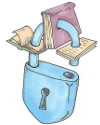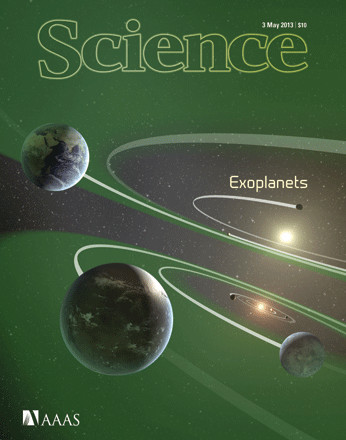Science under lock and key. The second part of

Continued. The first part of the translation was published yesterday.
')
No one to blame but myself
Critics of the monopoly of private publishers offer a simple solution - open access journals. Just like regular magazines, they accept articles, organize the review process and publish them. But they do not require a subscription fee — all articles are freely available online. To cover the costs, they take from scientists who want to publish a small fee (an average of about $ 2,000). Reviewers who decide which articles to publish do not receive money from magazines to avoid the temptation to accept everything. Unlike traditional journals, which require exclusive copyright in exchange for the opportunity to publish, open access journals are practically free of copyright restrictions.
If universities finance research, and their staff both write and review articles, then why haven’t they still not switched to open access journals? There are very few successful examples of open source projects such as the Public Library of Science . The thing is that the current scientific culture makes such a transition very difficult.
The history of publications in prestigious journals is a necessary condition for advancing along the scientific career ladder. Each article published in a young and not yet established authoritative open access journal could be published in such market flagships as Science or Nature. And if you can still imagine a professorial idealist already occupying a good position, who is ready to sacrifice part of his prestige for the sake of science, then what about his young co-authors, for whom an article in an authoritative journal can mean everything?
Governments could change this status quo by forcing them to provide open access to all research conducted at public expense. In the United States, the state allocates $ 60 billion annually in the form of research grants. In 2008, Congress, overcoming the fierce resistance of publishers, obliged them to give free access to all articles based on research conducted by the National Institutes of Health (which accounts for half of all state financing of science) a year after the first publication. Spreading this practice to all other branches of science could give a strong impetus to the development of open access journals. Such measures are being considered by the governments of Great Britain and Canada.
The costs of a closed publication: article Reinhard-Rogoff
The discussion of the 2010 Growth in Debt article, published by Harvard economists Carmen Reinhard and Kenneth Rogoff in the American Economic Review, demonstrates some of the problems of the scientific journal system.
Based on data on GDP growth and the level of public debt in different countries, the authors concluded that GDP growth is significantly slower in countries where the level of debt exceeds 90% of GDP.
Journalists, politicians and officials referred to this article to justify the reduction in government spending. Although the conclusions in the article itself are not so straightforward and categorical, Reienhard and Rogoff did Washington a favor in reducing the budget deficit.
But in April of this year, a group of scientists from the University of Massachusetts at Amherst found an error in an article by Reinhard-Rogoff. Like many other economists, scientists tried unsuccessfully to reproduce the results of Reinhard and Rogoff. And only when Harvard colleagues sent them the original data in Excel spreadsheets, they understood in Massachusetts why no one could reproduce these results. Error in the formula. Five data cells are not in the range. Without this error and some controversial points of the used method of weighing the results, the Reinhard-Rogoff effect was not observed. Instead of a decrease of 0.1%, countries with a debt above 90% showed GDP growth at a quite decent 2.2%.

The error was found, but within two years many influential politicians and economists referred to the article.
Bad motives
The transition to open access journals will increase the availability of scientific knowledge, but if the existing exaggerated role of scientific articles remains, then the reform of science will remain incomplete.
The journal system slows down the publication of research results. Peer review rarely takes place in less than a month, and journals often ask authors to rewrite part of the article or conduct additional research. As a result, the time to publish an article is stretched for half a year or more. Although quality control is necessary, due to the flexibility of the Internet, articles now do not have to be fully completed before publication. Michael Aizen, co-founder of the Public Library of Science, says that, according to his experience, “most of the serious flaws are only discovered after the article is published.”
People welcome the discovery of new drugs, scientific theories and social phenomena. But, if you remember that the process of scientific research is that all possible hypotheses are sifted through the sieve of the experiment in the search for the right one, then you have to admit that the negative results are just as important as the positive ones.
But journals cannot maintain their prestige by publishing reports of failed experiments.
Because of this, the scientific community is devoid of valuable information about unconfirmed hypotheses. Moreover, it pushes scientists to adjust the results and the overly optimistic conclusions that are not based on reliable data, and in which even the author himself is not sure. As long as science does not outgrow the modern journal system, we will not know how many false “discoveries” have been made because of the desire to show at least some result.
The scientific process in the XXI century
Although scientists are at the forefront of progress, they quite often miss the opportunities that technology provides.
Collecting information about scientific journals and the organization of scientific work in general, we spoke with representatives of Banyan , a startup whose mission is to promote openness in science. We were amazed at how many things can be done now, without any revolutionary breakthroughs in technology. "We are aiming at the review process - Banyan CEO Tony Gemayel told us - a lot of people still print their articles and physically send them to reviewers or send them by mail in .doc format."
Banyan recently launched a public beta of its product, which allows sharing, collaborating, and publishing research results. “At the core of our company,” explains Tony, “is the confidence that scientists will switch to Open Source if they are given simple and convenient tools.”
Michael Nielsen, a physicist and propagandist of open science, colorfully describes what new tools should look like to help spread a culture of collaboration and openness among scientists.
One of these tools already exists. This is arXiv - a site that allows physicists to publish the preprints of their work before the official publication of the article. This contributes to faster feedback and the spread of new discoveries. Nielsen also advocates the publication of not only the findings, but all the source data - physicists have long dreamed of this, and journals could help them in this if they wanted.
He tells about tools that do not exist yet. For example, a system of interconnected wikis that would allow scientists to create and maintain the most complete and relevant " superbooks " in their areas of research, which all their colleagues could use as reference books. Or an effective system of mutual assistance of scientists of different specialties, in the case when research leads to “foreign territory” (even Einstein did not develop the General Theory of Relativity independently, he needed the help of mathematicians). A full list of his proposals can be seen in the wonderful article " The Future of Science ."

Unfortunately, none of these remarkable innovations will work on a large scale, unless scientists have tangible incentives to use them. As long as the portfolio of publications in prestigious journals remains the main and only measure of a scientist’s professionalism, those who spend their time mostly on collecting data or creating a wiki are doomed to stagnate in their careers.
Speaking about this issue, Tony cites the example of the spirit of openness that prevails in the world of free software development. “In science now there is no system of rewards for openness. You can't make a career on it. But in programming, everyone wants to take a look at your account on Github. ”
Talented programmers spend many hours of their time on absolutely free work on products that anyone can use, although they could have earned a lot of money in freelancing during this time. On the one hand, many people work for free just to solve more complex and interesting problems, or simply because there is a powerful free development culture in programming. Thousands of companies and products simply would not exist if there were no open source software.
But programmers also receive personal benefits from working on free software, as colleagues in this work evaluate their abilities. Employers are carefully studying accounts at Gthub (they almost replace a resume), and a solid list of open projects and literate and interesting articles on professional blog topics plays a big role in the employer's eyes. Science would have to work the same way. But while such a system has taken root only in Silicon Valley - only here you can make a career in openness.
Destruction of science
The organization of scientific work, the way we do it, will change more strongly in the next 20 years than in the past 300.
Michael Nielsen .
The existing scheme of state financing of research and the subsequent publication of their results in scientific journals developed during the time of Isaac Newton and successfully solved the problems of science of the XVII century.
Starting in the 1960s, private companies began to buy out scientific journals and receive an unfair reward from the copyright of scientific articles. This has already led to a panic in the ranks of poor university libraries. But an even bigger problem is that scientists cannot fully utilize the opportunities for cooperation and the dissemination of knowledge provided by the Internet.
The destructive effect of this “cannot be measured or assessed,” says Tony Gemayel, “we don’t know what discoveries could have been made and what problems could have been solved if knowledge had not been locked behind high financial fences. Imagine what would have happened if Tim Berners-Lee had not put his World Wide Web designs in the public domain, or patented them? ”
Proponents of open science bring strong facts in favor of the fact that the excessive importance attached to publications in scientific journals leads to excessive secrecy, embellishment and fitting of the results and slowing down scientific progress. Only a change in culture and the emergence of tangible rewards for openness will help create a new system of more open cooperation.
The Internet was created to help scientists share the fruits of their labor. Unfortunately, scientists are beginning to use its capabilities very late.
PS Today, another translation was published on Habré, revealing the topic of the conflict between scientists and publishing houses: " Elsevier is my contribution to his fall ." Do not miss!
Source: https://habr.com/ru/post/190046/
All Articles